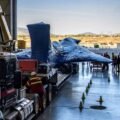A team of archaeologists recently explored prehistoric combat to shed light on how ancient warriors of the European Bronze Age fought.
Archaeologists study material cultures to understand how past peoples lived. This visceral series of experiments offers crucial baseline data, helping to contextualize the damage observed on certain martial artifacts and analyze their use.
Understanding the Past from Violence Today
A new study published in the Journal of Archaeological Science presented the team’s findings. Based at the University of Göttingen in Germany, the researchers tested bronze spear points against other materials they would have encountered in ancient times. These included the types of wood used in shields and other weapons, as well as animal tissue to simulate the spears’ impact on the human body.
“Our experiments will benefit future research because we have created a useful guide to recognize and understand the wear and tear on Bronze Age weapons,” said Dr. Valerio Gentile, lead author of the paper. “This information source will enable researchers and museum curators to study the objects already in their samples and collections with a fresh perspective. They can compare the marks they find with the ones we have documented and made freely available.”
“Our findings show how weapons were used and what techniques were employed,” Gentile added. “We may also be able to use our research to find out whether the Bronze Age weapons were used in large-scale battles or in duels. This is important for understanding the nature and intensity of conflicts in the past.”
Planning Bronze Age Weapons Tests
Combat is often unpredictable, and the reality of spear thrusts in life-or-death scenarios is far more complex than the controlled environment of a laboratory. This posed a challenge to the controlled reproducibility of the scientific method. To address this, the team began with tightly controlled tests and gradually progressed toward more realistic impacts. They continually compared new data with the controlled set to ensure greater confidence in the results while gathering information from more authentic scenarios.
The researchers were uniquely qualified for the task as both trained archaeologists and expert martial artists recognized by the National Sport Federation of Historical European Martial Arts of the Netherlands (HEMA-bond) as trainers. Ørjan Engedal, who is both an archaeologist and a bronze smith, fabricated the weapons used in the study. His reproductions were based on actual artifacts and used alloys that would have been available at the time.
The wooden shield was constructed using somewhat more modern techniques but maintained the dimensions of the original, accounting for wood shrinkage over time, and generally behaved like a period-accurate shield. The animal carcasses used in the experiments were discarded by a butcher. While missing much of the edible flesh, they closely approximated parts of the body that are often struck in combat, such as the head and arms, where skin and bone lie relatively close together.
Engaging in Combat
The exact fighting techniques of prehistoric Europeans remain unknown, but later written manuals on the use of pole weapons provided a basis for developing plausible techniques. The experiments simulated two phases of combat. The first, the “engagement phase,” focused on initial weapon-on-weapon contact as combatants struggled for dominance. The second, the “wounding phase,” mimicked the moment when one combatant overcame the other’s defenses and struck a blow at exposed flesh. The researchers explored various technical fighting styles within these broader categories using both one- and two-handed spears.
The damage observed on the weapons during the initial, highly controlled tests closely resembled that found on actual artifacts. A well-established system for cataloging specific types of weapon damage already exists, and the controlled testing offered deeper insights into the causes of these deformations, such as the angle of impact. The free sparring portion added further insights into the nature of ancient combat. One notable finding was the slight bending in a spear tip when it impacted a shield being pushed in dynamic defense, which differed from a controlled test where a spear was thrust into a stationary shield.
The Future of Ancient Combat Research
The team’s work provides researchers with valuable information on how bronze weapons wear in combat. Some of the most intriguing data concerned the gradual wear as objects were repeatedly struck during a duel. Additionally, the data highlighted the weaknesses of spear shafts under these conditions, suggesting areas for further research on how prehistoric warriors may have mitigated such vulnerabilities. Moving forward, archaeologists can use this enhanced understanding of weapon wear to reconstruct combat techniques from Bronze Age artifacts.
The paper “Multi-stage experiments in Bronze Age spear combat: insights on wear formation, trauma, and combat contexts” was published in the Journal of Archeological Science in October 2024.
Ryan Whalen covers science and technology for The Debrief. He holds a BA in History and a Master of Library and Information Science with a certificate in Data Science. He can be contacted at ryan@thedebrief.org, and follow him on Twitter @mdntwvlf.

